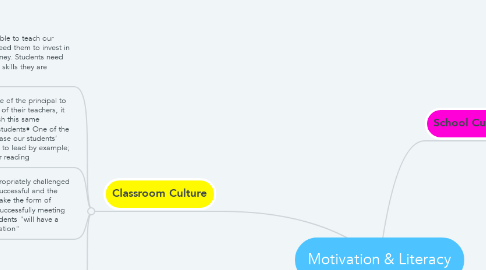
1. Classroom Culture
1.1. In order for us to be able to teach our students to read we need them to invest in their own reading journey. Students need to see the value in the skills they are developing.
1.2. Much like it is the role of the principal to ignite the motivation of their teachers, it is our role to establish this same atmosphere for our students• One of the easiest ways to increase our students’ motivation to read is to lead by example; share our passion for reading
1.3. if "students feel appropriately challenged to be academically successful and the rewards of learning take the form of problem solving or successfully meeting challenges" then students "will have a higher level of motivation"
1.4. Motivation can be supported by:
1.4.1. ◦establishing a rich literacy environment, highlighting from a young age authentic purposes for reading (i.e. class labels, visual schedules,etc…)
1.4.1.1. ◦Opportunities to be reading helpers (i.e. reading buddies)
1.4.1.2. ◦Classroom incentives are very beneficial to encourage young students (i.e. raz-kids)
1.4.2. ◦providing rich classroom library will offer students a variety of texts that will appeal to all preferences (i.e. magazines, poetry, non-fiction, etc..)
1.4.2.1. ◦Opportunities to read for fun (i.e. book clubs, book exchanges, reading beads)
2. Family
2.1. Regular, ongoing communication is key. McClelland found that “child-rearing practices that emphasize independence training and mastery produce people who are high in achievement motivation” (Maehr and Braskamp 1986, p. 21).
2.2. I communicate our learning goals regularly with parents through a variety of modes (i.e. classroom newsletters, Class Facebook Page, rubrics) to keep them informed of what we are working on
2.2.1. I invite families in regularly throughout the year to discuss their child's learning (i.e. student led conferences, interviews) and to share in their learning (i.e. Literacy Day, Reading Night)

